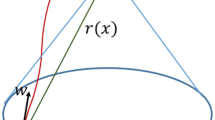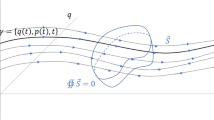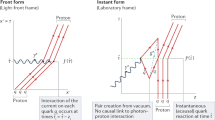Abstract
IN attempts to understand the relation between the quantum theory and the theories of relativity and electro-magnetism, a certain limitation, applicable to the motion of a particle of electromagnetic mass m0and of charge, is brought to light. It appears that the expression (m0c2d e/cmdxm) can assume only those values which are multiples of Planck's constant1. d is an element of proper time associated with the track of the particle, dxm is a component of displacement andm is a component of electromagnetic potential. An interesting result is obtained if this be applied to an electron in an electrostatic field of potential Ne/r. This is the case with an electron in an atomic orbit where N is the number of the atom. The above condition then implies (m0c22 Ne2/r)dt ® h where = 12;/c, ½ being the velocity of the particle, and where account is taken of the fact that the nuclear and electronic charges are of opposite sign. If we consider the case of the K-level of an atom and make use of Sommerfeld's value for Ne2/r, which may be regarded as a sufficient approximation, we obtain m0c2 (2 2/=2) dt ® h. In this case = Nα, where is the fine-structure constant 2e2/hc. We note that as approaches the value 1/2 the factor of dt approaches zero very rapidly, and the limitation states that the least possible value of dt is very large. We interpret this as an indication of the breakdown of the description of the charge as a particle in motion. This gives a clue to the nature of the limitation. It provides us at each point of space and time with a criterion for the dynamical description of an electric charge.
This is a preview of subscription content, access via your institution
Access options
Subscribe to this journal
Receive 51 print issues and online access
$199.00 per year
only $3.90 per issue
Buy this article
- Purchase on Springer Link
- Instant access to full article PDF
Prices may be subject to local taxes which are calculated during checkout
Similar content being viewed by others
References
Flint, Proc. Roy. Soc., A, 159, 45 (1937).
Flint and Richardson, Proc. Roy. Soc., A, 117, 637 (1928).
Author information
Authors and Affiliations
Rights and permissions
About this article
Cite this article
FLINT, H. An Application of a New Limitation in Physical Theory. Nature 142, 535–536 (1938). https://doi.org/10.1038/142535b0
Published:
Issue Date:
DOI: https://doi.org/10.1038/142535b0
Comments
By submitting a comment you agree to abide by our Terms and Community Guidelines. If you find something abusive or that does not comply with our terms or guidelines please flag it as inappropriate.



